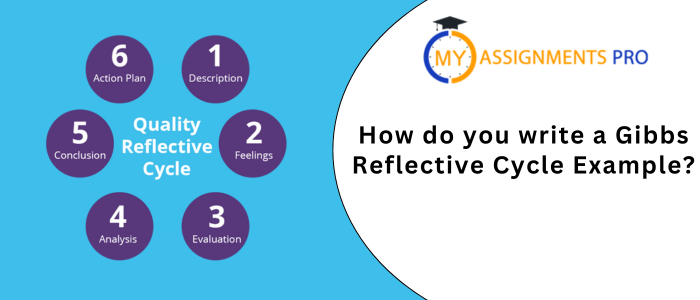
Reflection has become an indispensable instrument for academic and personal growth in the highly dynamic sectors of education and professional development. The Gibbs reflective cycle is one of the most popular models of reflection. Students are able to critically analyze an experience and deepen their insight with the structured approach provided by this framework, especially those in nursing and healthcare fields. Effectively capturing a learning event or writing an assignment is at the heart of this idea
In this blog, we are going to explain the theoretical part, usage, and example application of the Gibbs reflective cycle so that you can be sure it fits your practice. Also remember that if you ever feel stuck, My Assignments Pro is always there to give you the support you need with professional writing.
What Is the Gibbs Reflective Cycle?
The Gibbs reflective cycle is the most widely used model for structured reflection, especially in professional, academic, and healthcare fields. This framework, which was initially published in 1988 by Graham Gibbs, offers a systematic process to people who are looking to improve their skills, identify their weaknesses, and carry out those changes over time. As it facilitates a continuous learning loop, the Gibbs model of reflection fits well for professionals, students, and most of all, those who work in clinical environments like nursing.
Nurses typically utilize this method when applying the Gibbs reflective cycle nursing to think and talk about their clinical experience, patient interaction, and decision-making process. It enables nursing professionals and students to explore in a more critical fashion what has happened in the clinical setting and how they can transfer or change successful behavior in the coming days.
There are six main stages in the cycle:
- Description – Outlines what occurred during the experience.
- Feelings – Explores emotional responses and initial thoughts.
- Evaluation – Assesses what was good or bad about the experience.
- Analysis – Examines the reasons behind outcomes or behaviors.
- Conclusion – Suggests alternative actions or outcomes.
- Action Plan – Develops strategies for handling similar situations in the future.
Due to its systematic design that ensures the reflection part is not ignored, it is a good tool for academic assignments and professional development. In a Gibbs reflective cycle example, a nursing student might choose a situation where they communicated with a patient and go through each step in order to find out their strengths and correct any mistakes.
The Gibbs reflective cycle is the key to realizing your potential, becoming better, and taking responsibility, all of which are very important in practice and education. This approach helps you to come up with good ideas after each experience, be it writing a Gibbs reflective cycle nursing example or checking a presentation in class.
Why Is the Gibbs Reflective Cycle Important?
The Gibbs reflective cycle is a powerful tool for professional and personal growth, aside from academic use. This process helps you to critically evaluate your behaviors and make soundly informed changes, whatever your profession—nursing student, educator, or business executive. Let us see why the Gibbs reflective cycle is such a valuable tool in many educational and professional settings.
Promotes Deep and Structured Thinking
The Gibbs reflective cycle offers a clear, six-stage model that takes students through an experience in step-by-step detail, as opposed to informal reflection. It allows people to effectively review their thoughts, actions, and decisions by dividing the reflection into many different stages: Description, Feelings, Evaluation, Analysis, Conclusion, and Action Plan.
It invites students to see beyond surface observations and seek the "why" and "how" of their experiences through numerous examples of the Gibbs reflective cycle.
Supports Continuous Learning and Improvement
The Gibbs model of reflection's cyclical structure highlights continuous improvement. Every step builds on the one before it, ending in an action plan that gets you ready for potential future situations. This is especially important in practical domains like healthcare, where patient outcomes can be directly improved by learning from real-world experiences.
For example, in the nursing examples from Gibbs' reflective cycle, students consider their clinical experiences to determine what worked and what needs to be improved, ultimately forming better practices.
Encourages Self-Awareness and Emotional Intelligence
Focusing on feelings is one of the important facets of the Gibbs reflective cycle. Students can understand the effects of their feelings on their responses and behaviors by including a stage of "Feelings." This builds emotional intelligence and self-awareness, which are essential in high-pressure situations such as classrooms and hospitals.
Addressing worry, confidence, or empathy within clinical settings in a well-designed Gibbs reflective cycle nursing example will help students develop emotionally and professionally.
Improves Academic and Workplace Performance
Performance on placements, assignments, and actual tasks gets better when reflection is carried out after the Gibbs reflective cycle. Besides enhancing skills such as communication, critical thinking, and decision-making, it helps learners grasp expectations and recognize gaps in knowledge.
Using a group project or clinical assignment with an example from the Gibbs reflective cycle, reflecting can expose team dynamics, leadership skills, or areas where procedures should be altered.
Aligns with Academic and Professional Standards
Because of its systematic methodology and connection to professional norms, the majority of colleges and training facilities promote the application of the Gibbs reflective cycle. In the Gibbs reflective cycle nursing evaluations, where students are judged on their capacity to consider ethics, teamwork, and patient care, it is particularly preferred.
In order to demonstrate practical learning results during clinical assignments, students are actually required by many nursing programs to present a Gibbs reflective cycle nursing example.
Improves the Ability to Make Decisions and Solve Problems
The Gibbs reflective cycle helps you make better judgments by evaluating past acts and forecasting future results. It pushes you to think about other options and equips you to deal with comparable circumstances more skillfully and confidently.
Step-by-Step Guide: How to Write a Gibbs Reflective Cycle Example
The Gibbs reflective cycle provides structure since reflection papers can generally be intimidating. Be it a healthcare professional, a nursing student, or a teacher trainee, one can critically and methodically analyze their experience following each step of Gibbs's model of reflection. This step-by-step guide will assist in making a clear and convincing Gibbs reflective cycle example, particularly emphasizing academic and practical usefulness.
Start with the Description Stage – What Happened?
So, start by giving an objective narration of the incident or circumstance. Simply explain what happened, without getting into Constitutive Analysis. For example: "During my nursing placement, I was asked to assist in the administration of medication to an elderly patient."
Move to the Feelings Stage – What Were You Thinking and Feeling?
Consider how you felt during the incident. Were you proud, frustrated, self-assured, or nervous? Emotional expression shows genuine participation and gives your Gibbs reflective cycle example more depth. Example: "Being my first time doing something hands-on, I was anxious before giving the medication, but I was also excited to put what I had learned into practice."
Proceed to the Evaluation Stage – What Was Good or Bad?
Analyze the positive and negative aspects of the situation. Consider what went well, what could have been better, and how the people involved responded. Example:
“The communication between the staff and me was clear, which helped the process go smoothly. However, I forgot to double-check the dosage initially, which was caught by my supervisor.”
Dig Deeper with the Analysis Stage – Why Did It Happen That Way?
Explain why things transpired the way they did using your theoretical understanding and critical thinking skills. Connect this to previous knowledge, rules, or models. For instance, shared by Gibbs reflective cycle experts: "I made a mistake because I was too preoccupied with following instructions and neglected to stop and check the dosage. Nursing best practices state that the key to avoiding mistakes in everyday duties is attention.
Draw Insights in the Conclusion Stage – Is there anything you could have done differently?
List the main lessons you learned. Consider what you've learnt and how you might handle a comparable circumstance in a different way the next time. For instance: "I came to understand how important it is to take your time and be thorough. I ought to have gone over the procedures in my head before seeing the patient.
End with the Action Plan Stage – What Will You Do Next Time?
This last phase focuses on how you will reproduce or enhance successful actions going forward. It transforms introspection into a growth tactic. For instance: "Next time, I'll make sure all of my medications are in order and practice runs to boost my confidence."
Need Help Writing Your Gibbs Reflective Cycle Example?
My Assignments Pro can assist you if you struggle to articulate your experience or match it with academic requirements. Our specialty is providing healthcare, education, and other fields with individualized, superior Gibbs reflective cycle examples. Our nursing care assignment help professionals can help you professionally structure your assessment because they are knowledgeable about the nuances of the Gibbs model of reflection. Additionally, we offer:
Mitchell
Mitchell is a seasoned Ph.D. scholar with extensive expertise gained through years of rigorous research, publication, and teaching experience. He brings a wealth of knowledge and analytical skills to tackle complex academic challenges. His work is dedicated to delivering innovative solutions, advancing knowledge, and promoting academic excellence. Proficient in research methodology, data analysis, and scholarly writing, Mitchell has contributed to peer-reviewed journals and mentored students to achieve academic success.


